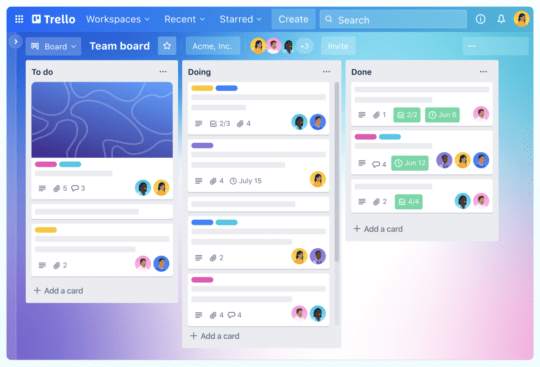Understanding the basics of horizontal management
Definition of horizontal management
Horizontal management, as opposed to vertical management, reverses the traditional pyramid of organizational charts in favor of a “flatter” structure, reducing intermediate hierarchical levels. Unlike the vertical system, where power and decision-making are concentrated at the top, horizontal management eliminates layers, promoting collaboration, transparency and autonomy. Teams work in a network rather than a cascade structure, enabling fluid communication and agile decision-making processes.
The key principles of horizontal management
Horizontal management is a type of management that emphasizes team cohesion. It’s a different way of managing, based above all on empowering employees and giving them a sense of responsibility.
All employees, even apprentices and trainees, are encouraged to share their ideas, take the initiative, propose solutions and ultimately take charge of their own careers. By giving the same value to every employee in the company, regardless of seniority, age or hierarchical level, this type of management ensures greater involvement.
Feeling considered, heard and listened to, employees are eager to make their contribution to the company’s development. His initiatives are valued, which makes him want to invest himself fully in his work and achieve his goals. At a time when well-being and quality of life at work are recognized indicators of productivity, this type of management is being increasingly adopted by companies.
Finally, horizontal management implies horizontal decision-making. Each employee is involved in the decision-making process, and each vote counts as much as the other. Collectivity prevails over individuality. By eliminating hierarchical levels, everyone feels involved and stimulated, allowing new ideas to emerge.
Horizontal management is based on these principles, and offers multiple benefits at both individual and collective levels.
The benefits of horizontal management
Promoting collaboration and communication
As mentioned above, horizontal management offers a number of advantages. Firstly, horizontal management encourages collaboration and communication. Freed from silos, information flows better and more freely within the organization. Team spirit is strengthened as everyone is on an equal footing. As a result, teams adopt a more direct, transparent communication style, and solve problems more quickly. By encouraging transparency and valuing each member’s contribution, horizontal management lays the foundations for a corporate culture where collaboration and communication are essential pillars of collective success.
Encouraging employee autonomy and empowerment
Horizontal management intrinsically empowers employees. It fosters a climate in which every team member is encouraged to take the initiative, since responsibility is no longer reserved for the upper echelons, but is distributed equitably. By giving employees an active role in decision-making, horizontal management strengthens their sense of belonging and involvement. This approach also offers opportunities for continuous learning, as employees are encouraged to develop a wide range of skills that they might not have developed so quickly under a more vertical management system. Empowerment and autonomy are the pillars of horizontal management. The resulting autonomy stimulates creativity, encouraging innovation.
Stimulating innovation and creativity
Horizontal management is also proving to be a powerful catalyst for creativity and innovation within companies. By eliminating hierarchical barriers, it encourages the free flow of ideas, creating fertile ground for innovation. Teams interact seamlessly, allowing for a diversity of viewpoints and experiences. The autonomy granted to employees in such a setting stimulates initiative-taking and the exploration of new approaches; from this can emerge innovative ideas. Horizontal management creates an environment conducive to innovation and the emergence of creative solutions.
Improve employee satisfaction and commitment
Finally, horizontal management is an essential driver of employee satisfaction and commitment. This management style gives employees a heightened sense of importance, thanks to their ability to make significant contributions. By encouraging active participation in the decision-making process, horizontal management strengthens the bond between employees and the company, cultivating a strong sense of belonging. The autonomy given to employees in carrying out their tasks fosters a fulfilling work environment, where everyone feels valued and competent. The transparency that characterizes this model reduces friction and misunderstandings, contributing to a climate of trust. In short, horizontal management creates the ideal conditions for a satisfied workforce, committed and invested in the company’s collective success.
The benefits of horizontal management for the company
In addition to the individual benefits for the company (higher productivity, greater commitment, etc.), there are numerous benefits for the company itself.
Adopting a horizontal management style shows that the company is keeping up with the times and adapting to changing working practices. In a world where innovation and digitalization are paramount, agility is the order of the day, and vertical organizational systems have less place in the face of current and future challenges.
Finally, optimizing the company’s operations from the inside is reflected on the outside, with a better brand image and employer brand.

Horizontal management practices and tools
There are a number of practices specific to horizontal management, and many tools that promote collaborative management.
Participative management and collective decision-making
Participative management and collective decision-making are essential elements of horizontal management. In this model, participative management implies the active involvement of employees in decision-making processes. This approach fosters a climate in which everyone contributes to the formulation of strategies and solutions, harnessing the wealth of collective knowledge. Decision-making becomes a collaborative effort, eliminating the burden of unilateral decisions. Participative management strengthens employees’ sense of belonging, stimulating their involvement in achieving the company’s objectives. Participative management, in the context of horizontal management, is a key to unleashing the collective potential of teams and stimulating continuous innovation, as we saw earlier.
Examples of participative management and collective decision-making
Business process review The teams, made up of members from different departments, meet regularly to assess the effectiveness of existing procedures and suggest improvements. Everyone has the opportunity to share their expertise, fostering a global understanding of operational challenges. Collective decision-making comes into play when it comes to choosing the adjustments to be made. This approach not only improves operational efficiency, but also strengthens employees’ sense of belonging.
Collaborative strategic planning Brainstorming sessions involve members of various hierarchical levels, enabling a diversity of perspectives. Major strategic decisions, such as introducing new products or expanding into new markets, are taken collectively. This participative management ensures that strategic decisions are informed by the experience and vision of the entire team, creating a more robust strategy that is aligned with the company’s overall objectives.
Transparency and open communication
Transparency is a pillar of horizontal management, eliminating the traditional barriers between management and employees. Crucial information, such as strategic objectives and key decisions, is shared openly, fostering a sense of trust within the organization. Communication becomes a two-way channel, encouraging employees to express their ideas and concerns. This openness strengthens commitment, enabling everyone to feel involved in decision-making processes.
Examples of transparency and open communication :
Setting your remuneration In some companies where horizontal management is practiced, employees can set their own remuneration. To do this, they must take into account their level of responsibility, seniority, the company’s salary scale and financial resources.
Open and transparent meetings : meetings are accessible to all employees, as long as everyone actively participates in the meeting. Top-down meetings are a thing of the past, with everyone playing their part.
Setting up horizontal organizational structures
Horizontal management requires profound changes to the company’s organizational structure. This means deconstructing old, established models and introducing new, horizontal practices such as those we saw earlier. This includes :
- the elimination of intermediate management levels;
- the introduction of a new, more transparent mode of communication;
- the reorganization of workspaces to facilitate exchanges and collaboration;
- establishing a collaborative mindset and a general climate of trust;
- simplifying decision-making processes and procedures;
- the introduction of collaborative tools to facilitate this type of management.
Examples of actions to set up a horizontal structure within your company:
Free choice of manager : let employees appoint their own managers. Employees are more likely to trust someone they have chosen, which in turn facilitates communication and transparency.
Make all employees shareholders of the company. It’s a strong measure, but one that has the advantage of motivating everyone to invest fully in the company’s strategy.
Digital tools for horizontal management
Today, numerous digital tools exist to facilitate exchanges and immediate, transparent and close communication between each department and each level of the company. A key step will therefore be to install these digital communication and project management tools and get them adopted by employees.
Examples of digital tools for horizontal management :
Project management platforms Tools such as
Trello
,
Asana
or
Monday
facilitate collaboration and task management in horizontal teams.
Instant messaging and collaboration platforms such as
Slack
or
Microsoft Teams
encourage instant communication and real-time collaboration, using communication channels dedicated to each project.
Knowledge management tools platforms such as
Confluence
or
Notion
enable knowledge to be created, shared and organized within the company.
360° feedback systems tools such as
15Five
or
Lattice
enable 360-degree feedback to be collected, fostering a culture of continuous feedback.

Tips for implementing horizontal management in your company
Implementing horizontal management in a company requires a methodical approach and thoughtful change management. Here are a few essential tips for a successful transition.
First of all, start with a gradual transition. Implement horizontal management in pilot teams before rolling it out across the organization. This will reduce resistance to change and facilitate adaptation.
Communication is crucial. Communicate clearly about the changes, explaining the motivations, the expected benefits and the implications for employees. Transparency encourages buy-in and reduces uncertainty.
Actively involve employees in the transition process. Encourage their participation by collecting their ideas, organizing brainstorming sessions and creating working groups. Their involvement strengthens buy-in and contributes to a smoother transition.
Adapt your HR practices to support horizontal management. This can include adjustments to recruitment, training and skills management policies to encourage the emergence of versatile, autonomous skills.
Evaluate results regularly. Set up key performance indicators to measure the effectiveness of horizontal management. Learn from experience and adjust practices accordingly.
Encourage a culture of continuous feedback. Establish formal and informal mechanisms for gathering employee feedback. This encourages continuous improvement and strengthens the bond between management and teams.
Set up collaborative tools to help adopt new, more transparent ways of working and communicating. Train all employees in the tools to facilitate their adoption.
Finally, to help you make the transition to a more collaborative management style, you can call on the services of
interim managers or external HR experts
. They’ll provide you with a fresh perspective and a sense of perspective, and will facilitate the implementation of these new processes thanks to an action plan defined upstream. They can also support managers in their transition, through individualized coaching. Indeed, managers will often have to shift from the posture of a leader to that of a coach, a whole state of mind and ingrained habits that they have to change.
By following these tips, managers can ease the transition to horizontal management, creating an environment conducive to innovation, collaboration and employee satisfaction.
Conclusion
In conclusion, horizontal management is emerging as an organizational model in tune with our times, sometimes profoundly redefining the way companies operate. By encouraging collaboration, autonomy and empowerment, this type of management stimulates innovation and strengthens employee commitment. Transparency and open communication, the cornerstones of this approach, create an environment conducive to mutual trust and employee fulfillment. Operational agility, collective decision-making and skills diversity enable a resilient corporate culture, adapted to the challenges of the fast-moving digital world. Participative management, combined with a gradual transition and ongoing evaluation, form the basis of a successful transition to horizontal management. By adopting this type of management, companies can not only thrive in a changing environment, but also foster a positive dynamic within their teams, propelling the company into the future with confidence and success.


